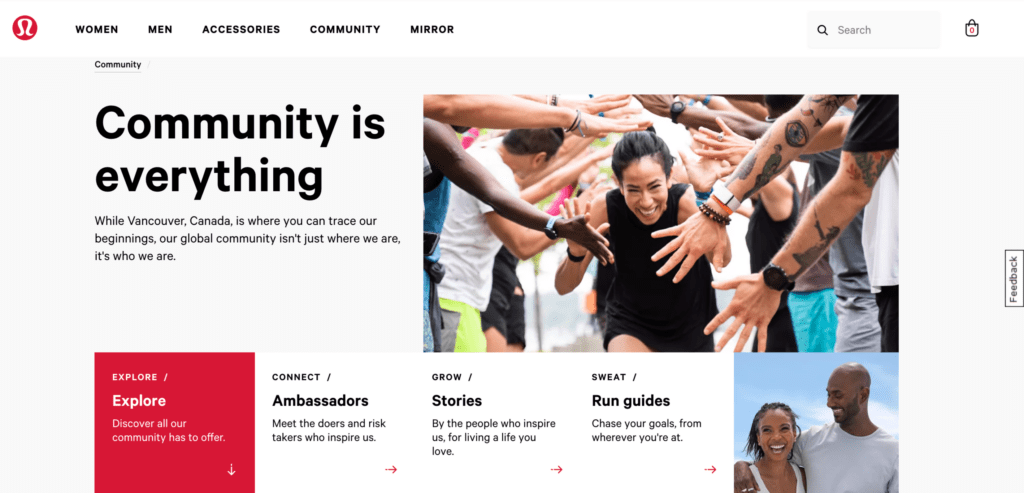
Have you noticed that the biggest brands most of the time also have a passionate brand community?
A community of people so passionate about the brand that each time a new product launches, they need to have it.
Which brands come to mind? Starbucks, Apple, Sephora, Playstation, Lego are a few examples of brands with customer bases that really feel a connection to them.
You might think that the communities are a product of the success of the brand and they naturally appear, but actually, brand communities are one of the most important reasons for their success.
In this article, we will explain what exactly is a brand community and why you need to grow yours.
What is a brand community?
A brand community is a group of engaged customers that have a strong emotional connection to a brand. This community purchases the brand’s products, interacts with their digital content, and is already promoting the brand within their inner circle. They’re not just interested, they’re invested.
Sure, you have a customer base, but would you call them your community? Hopefully, you answered yes.
As you can see from our brand community definition, once people have an emotional connection with your brand, they become loyal customers.
There are many ways brands can develop an emotional connection with their customers.
Many times it starts with the product. People can like products for their practical utility and quality, but they fall in love when the product design and marketing resonates with them.
Another way is directly engaging with customers. Nowadays you can see brands talking to their followers on any social media platform every day, and not only for customer service. Sometimes they are even exchanging memes.
Of course, the approach brands take with this communication depends on their target audience.
The idea is to treat consumers in a personal and genuine way. We will explain in the following section why this is important.
Recommended: What is Community Marketing?
Why you need a brand community
Consumers, especially newer generations, don’t want to just buy from brands, they want to partner with brands.
The brand that they just buy from won’t receive the kind of support they would give to brands they have a connection with.
That might sound strange to some, but it’s true because nowadays people buy on belief.
That’s why 64% of people would support or boycott a brand just based on its position on social or political issues.
You could say, people see brands almost like an extension of themselves, so it’s very important that you develop a strong relationship with your audience and build a community around your brand.
In fact, 88% of community professionals believe that community is critical to the company’s mission.
Let’s take a look at the specific benefits of brand communities to see how they create value.
Recommended: How to Build an Online Community
Benefits of brand communities
Brand communities increase brand loyalty
Brand loyalty contributes to the success of brands more than people think. After all, loyalty is what is stopping your customers from changing companies.
Just think about it. It’s not too difficult to imagine that someone would change companies just for the difference in prices or because he/she identifies more with the other company.
However, that wouldn’t happen if the person feels a connection and likes to support the first brand. They are loyal customers. Otherwise, everyone would just go for the lowest cost product every time.
Brand communities play a big role in increasing loyalty.
53% of Americans who follow a brand on social media are more loyal to the brand.
By building a brand community consumers want to be a part of, you are making people want to support you. Resulting in increased brand loyalty, customer retention, and repeat purchases.
Brand communities create advocates
Advocates are your biggest fans. They are customers who really love your products. So much so that they love to talk about them. It’s not uncommon to see people even collecting products from brands they like. Although, they don’t have to do that to be considered advocates.
Advocates are huge for brands because they spread their message genuinely out of their love for them. These genuine recommendations have a lot of influence on purchase decisions.
That’s because people trust brand recommendations based on experience more than any other source.
If someone says a product is great, then you believe it because they already tried it. And if someone tells you that they love a brand, it must be for a reason.
For those reasons, it’s in your best interest to nurture the relationship with your customer base in order to create advocates for your brand.
Another benefit of having advocates is that they do more than just talk about you in person. They also follow you on social media, interact with your brand, and create content about you.
People engaging with your content increases the reach of your community. When they share your posts, more people see them.
Also, when advocates create online content like a post, video, story, blog post, or tweet, mentioning your brand, it’s like a personal recommendation, but to their entire network.
Gain insights on your customers
Communication is a key element in brand communities. People like to be listened to by the brands they like. And they are more than happy to provide honest feedback.
Brand communities give you the opportunity to receive feedback and new ideas to keep your marketing efforts fresh.
Being open to receive feedback is appreciated by consumers because it makes them feel that you care about improving. Obviously, you are always looking to improve in any way you can, but this way you are letting them know.
So, don’t be afraid to ask people what they think about your product and service. Sometimes you might not realize there is an area you should be improving.
In the same way, people will love to let you know what you are doing right. All of this information is important because you can focus on the things your target audience cares about.
Be involved in other communities
It’s clear that a community around your brand is very beneficial. However, you should also try to add value to the communities your consumers are part of.

Let’s take Lululemon as an example. There is a pretty big community around Lululemon as a brand. However, they also make an effort to add value to local communities with their brand ambassador program.
Their ambassadors regularly host fitness classes and events in Lululemon’s stores. This accomplishes a couple of things.
It gets people to go to the store and see Lululemon’s products.
It grows Lululemon’s brand community.
But it also adds value to local fitness communities by getting athletes and experienced fitness coaches to help people do their workouts better and learn new things.
So look at the communities your target audience is part of and try to genuinely add value. We emphasize that you do this with genuine interest because people can detect when brands just want to take advantage of something to sell.
Final thoughts on brand communities
People want to connect with brands, so do it. Set your goals on what you want to achieve, and create your own brand community.
If you need help, check out our ultimate guide on building a brand community. It has everything you need to know to start taking action.



